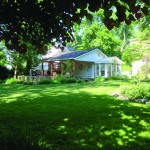Crocker Conservancy Preserves Rare Habitat
By Annie Young
The sound of kids playing echoes through the trees as I tramp along a mulched trail with Kit McGinnis, Development Director at Powhatan School in Boyce. I trip along trying to keep up with McGinnis, who is very familiar with the terrain. Although the students are playing on their playground through a small brace of trees, they are also familiar with this special piece of land. It is the Crocker Conservancy, the newest part of their campus and a premiere outdoor laboratory for students from pre- kindergarten through grade eight.
Agnes Crocker Brengle, Constance Crocker, and Isabelle Crocker Osborne donated the land from their family in 2011. The Crocker family donated the original land that Powhatan School Campus sits on today. Experts, community members, students, faculty and parents helped to create a plan for 30 acres of the conservancy. The whole acreage is now protected by a conservation easement. Through the exploration and planning it was discovered that the land held four unique habitats. The habitats include a riparian stream area with Roseville Run streaming through, a calcareous muck fen, hardwood forest and warm season grass and wildflower meadow. Not only are these habitats incredible places for learning but they also hold special conservation properties.
Simply put, a calcareous muck fen is a where a hill slopes into a spring seep with limestone in the area. It is listed by the Virginia Department of Conservation and Recreation as high priority for conservation. Decades ago, wetlands were drained to create more land for grazing cattle. Now this particular wetland has been properly repaired to allow the natural seep, fill and flow for the macroinvertabrae and plants to flourish. The calcareous muck fen is a rare habitat—not just in our area but in the whole world!
The riparian stream area creates a buffer zone along the Roseville Run to prevent erosion and conserve the soil. Where the land and the stream meet is important for plant life to provide structure so that run off does not occur. Conserving this area of land helps the whole watershed be healthier. The other habitats of the hardwood forest and warm season grass and wildflower meadow provide important habitats for pollinators and birds. As I tour the meadow, I see a killdeer skitter along the middle of the meadow as newly planted native species provide a thicker protection for its speckled eggs laid in a ground nest. The hardwood forest and meadow also demonstrate succession of tree growth.
These habitats are natural but take a lot of care to preserve. Volunteers, grants, donations, students, and families have cleared invasive vines, moved soil, planted native plants cleared trails, and mulched new trails. It takes a heroic effort to bring together the efforts of so many willing community members. McGinnis, as development director, has facilitated the partnerships with Virginia Department of Forestry, Clarke County, Casey Trees, Conservation Services, Blandy Experimental Farm, Natural Resource Conservation Services and the Alliance for the Chesapeake Bay. Parents have also taken an active role in creating this outdoor learning environment for their children. These community members have given their time, muscle, equipment, expertise and care.
This year the whole school participated in helping these habitats become more healthy. During the Tree-Themed Earth Week, students ages 4 to 14 planted over 100 trees on the campus. Small groups of older and younger students worked together to plant native trees. Volunteers and partners from various organizations came to support the effort. The trees were carefully lowered into huge holes dug by the students. They were properly protected with mesh and plastic tubes to prevent deer or other critters from damaging the hard efforts of the students.
Classes are currently using the Crocker Conservancy for their learning. The nature- enhanced approach to learning integrates into many subject areas, especially science, technology and mathematics. Learning about nature in nature is as rare these days as the habitats that are part of the campus. Teachers bring their students out to the shady areas where learning opportunities abound.
The new outdoor laboratory has handmade signs and benches created with conservation in mind and donated by caring individuals. Plans for learning pavilions and observation boardwalks will allow students to observe the habitats and wildlife.
Crocker Conservancy will be used to “implement a framework to connect to curriculum and kids,” says McGinnis. Students have already had an opportunity to connect with conservation as they planted their laboratory for future learning. Current and future students will take this gift of land and share their gift of conserving it.








